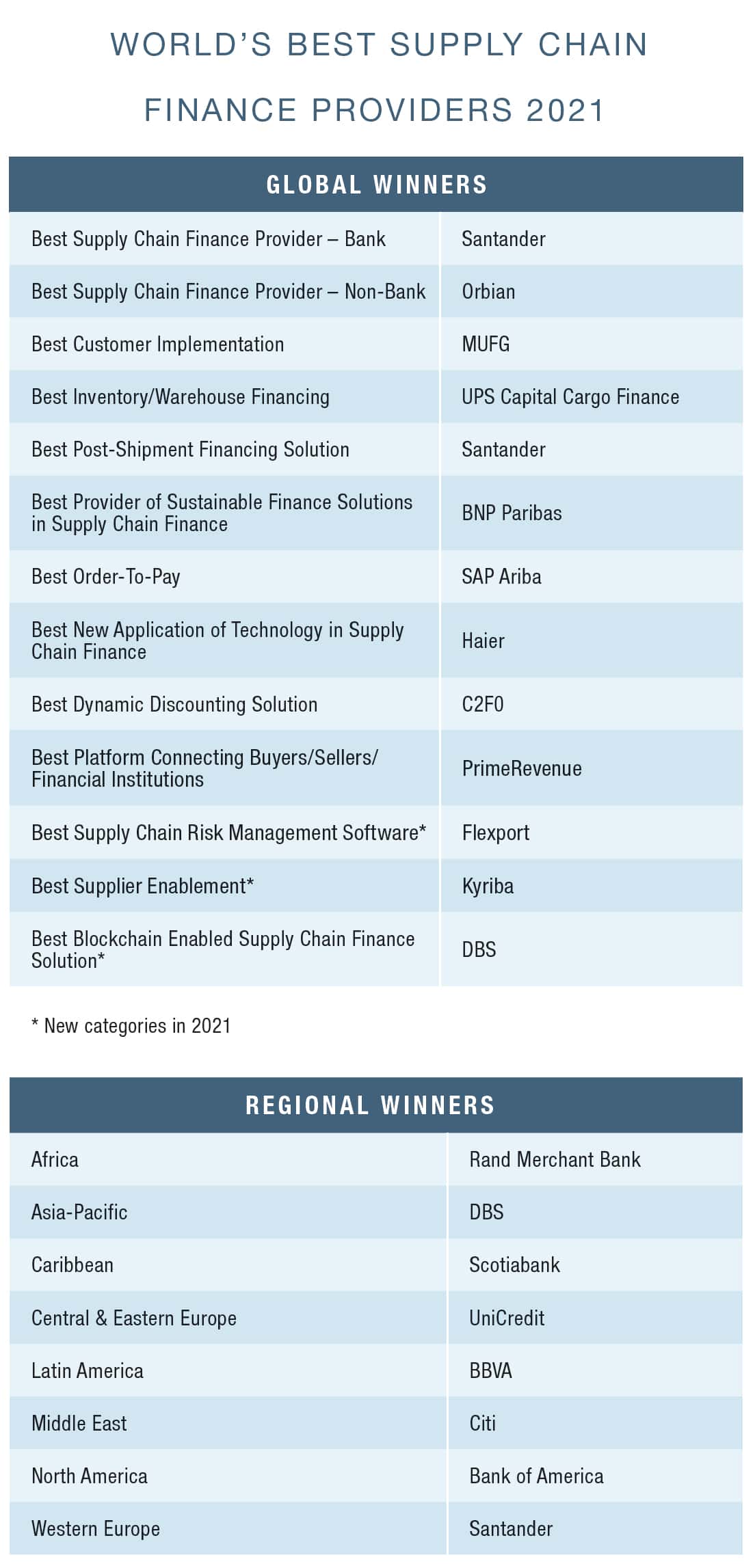Global Finance names the World’s Best Supply Chain Finance Providers for 2021, noting growth and innovation taking place in the long tail of SMEs.

Supply chain finance is the kind of facility that tends to prove its worth in the middle of a crisis. During the 2008 global financial collapse and the liquidity crunch that preceded it, banks touted supply chain financing (SCF) as an alternative to expensive bank lines of credit and debt financing. The term “working capital” entered common parlance, referring to the capital supposedly trapped in suppliers’ inefficient payables and receivables processes: the money owed by buyers that typically wanted to extend payment terms for as long as possible.
SCF allowed both parties to get their way: Suppliers were paid early by the buyer’s bank, sometimes in return for a discount on the invoice. With the bank coughing up the money on the buyer’s behalf, the buyer continued to benefit from the usual 60- or 90-day payment terms.
However, most of these SCF programs relied on large, creditworthy buyers selecting the strategic suppliers they wanted to work with. This meant suppliers at the longer tail of global supply chains—tiers two or three—rarely benefited. Yet, most companies in these tiers are small to midsize enterprises (SMEs) that typically have the greatest appetite or need for affordable working capital.
The point of this short history lesson in supply chain financing is to raise the question: Has the coronavirus pandemic changed how SCF works for suppliers? Many companies talk about how the pandemic has changed the world. But has it changed supply chain finance for the better?
Every year, we mention the trade financing gap identified by the Asian Development Bank, which now runs into trillions of dollars in emerging markets. Surely, SCF is a solution that could help plug that gap? But again, the problem lies in the way many of these programs are structured, with the buyers’ needs seemingly taking priority over the suppliers’. Many banks’ risk models also prevent them from financing suppliers in the lower tiers of supply chains.
Last year, however, something changed. Buyers were onboarding more suppliers, even those in the lower tiers, to existing SCF programs. Suppliers’ need for SCF was growing, as alternative forms of financing dried up or proved too expensive. We also saw the maturing of offerings from banks and fintechs and the growing use of technologies such as application programming interfaces and blockchain to deliver greater connectedness, transparency and the advertised advantages of paperless trade.
Among the winners of this year’s Global Finance Best Supply Chain Finance Providers, there is a growing recognition that SCF needs to benefit all parts of the supply chain. It’s no longer “a special solution for only the largest suppliers in key markets,” says Orbian, but also provides early liquidity to suppliers in more “vulnerable countries.”
Santander, another long-standing provider of SCF solutions and this year’s global winner as Best Supply Chain Finance Provider—Bank, has addressed the gaping hole in this market segment by developing new portfolio-based risk models that enable it to accept buyers anywhere in the world, even if it does not bank them, and focus on including more individuals and SMEs.
Fintechs continue to mature their SCF offerings, particularly in areas like dynamic discounting, where the buyer’s money is used instead of a bank’s to extend early payment to suppliers in return for a discount. Blockchain solutions have helped make the opaque world of global trade more transparent and predictable so that financing can be extended to multiple tiers of suppliers quickly and easily.
Add into the mix a global pandemic that has caused significant demand and supply shocks in global supply chains and cash shortfalls for companies that have had to endure months of disruption and lockdowns, and we have the kind of perfect storm that allows SCF to flourish and potentially realize its full potential. Despite these recent developments, there still exists the trillion-dollar trade financing gap. But a meaningful shift, reflected in the achievements of this year’s winners, is underway as new solutions enable all tiers of the supply chain to benefit from early payment for goods or services provided.

|
GLOBAL WINNERS |
|---|
BEST SUPPLY CHAIN FINANCE PROVIDER — BANK
Santander
With a global footprint spanning Europe, the UK, North America, Latin America, mainland China, Hong Kong and Singapore, Santander offers supply chain financing (SCF) solutions spanning multiple jurisdictions and currencies. Its Confirming solution, which extends early payment to suppliers based on approved invoices from buyers, operated locally in a number of markets for many years before the bank expanded it into a global solution. Santander also provides a wide range of financing solutions that address specific needs, including distributor finance; mass receivables; a global Receivables Purchase Program; and pre-confirming, which serves small and midsize enterprises (SMEs) using transactional data.
BEST SUPPLY CHAIN FINANCE PROVIDER — NON-BANK
Orbian
In the face of rising competition from fintechs, Orbian, which was founded in 1999 by software provider SAP and Citibank, has worked hard to establish itself as an innovator in the SCF space. With 100-plus buyer-led SCF programs already established and more than 5,000 suppliers enrolled, its SCF platform has secured a reputation among suppliers for ease of use and enrollment. Its virtual payment e-Card, which can be used in more than 150 countries, enables suppliers to get paid sooner, without having to go through the lengthy documentation process required in traditional supplier finance programs. The e-Card features enhanced privacy and security features; it provided as much as $400 million of liquidity to one supplier in its first months of operation, Orbian says. The company also recently launched Express SCF, which is designed to level the playing field by making SCF accessible for all suppliers, regardless of their size or where they are located.
BEST CUSTOMER IMPLEMENTATION
MUFG
With the coronavirus pandemic accentuating the need to preserve cash, Japan’s MUFG proposed a novel solution to a Fortune 200 oil and energy client: using dynamic discounting to deliver significant cost savings and better yields for the company’s excess cash balances. The client receives discounts on its payables or invoices in return for early payment to suppliers. MUFG says the annualized returns on the company’s cash were better than it could have obtained from short-term investments. While most banks have to partner with fintechs to offer dynamic discounting, which leverages the buyer’s funds instead of the bank’s, MUFG’s proprietary SCF platform supports both traditional SCF and dynamic discounting.
BEST INVENTORY/WAREHOUSE FINANCING
UPS Capital Cargo Finance
Logistics providers like UPS are better placed than banks to finance companies’ inventory or warehouses of goods and materials, since these providers transport goods and follow them most closely as they transit through global supply chains. Taking on ownership of another company’s inventory can be risky, however, particularly if ownership of the goods is in dispute. UPS’ financial and payment solutions division, UPS Capital, offers Cargo Finance, which helps suppliers finance new inventory, enabling them to fulfil more orders. UPS Capital Cargo Finance lends against in-transit inventory, promising more-attractive terms than traditional forms of finance.
BEST POST-SHIPMENT FINANCING SOLUTION
Santander
Santander was an early pioneer in supply chain finance with its Confirming solution, which offered early payment to suppliers, particularly in its core European and Latin American markets, based on approved payables or invoices from the buyer. In the past, its strategy was to develop local Confirming platforms in its core markets. But recognizing that its customers’ SCF programs were becoming more global in reach, Santander launched Global Confirming, which supports multiple currencies and countries. Recently, the bank leveraged its Confirming solution to help buyers looking to reward those suppliers that meet certain sustainability criteria. An invoice discount rate is linked to the supplier’s performance against specific KPIs. Suppliers are given an ESG rating or score. The bank has also built additional flexibility into its Confirming solution for those companies wanting to access financing from multiple funders or banks.
BEST PROVIDER OF SUSTAINABLE FINANCE SOLUTIONS IN SUPPLY CHAIN FINANCE
BNP Paribas
The French bank was one of the first to recognize the role financing can play in promoting more-sustainable supply chains and greater corporate social and environmental responsibility. By incentivizing suppliers with early payment or more-attractive financing terms if they support certain environmental, social and governance criteria, BNP Paribas aims to push compliance deeper into the supply chain. Accordingly, the bank has developed a proprietary framework for benchmarking suppliers’ adherence to sustainability key performance indicators (KPIs).
BEST ORDER-TO-PAY
SAP Ariba
The Ariba Network, one of the world’s largest digital marketplaces, allows buyers to consolidate their sourcing, procurement and payment for goods on a single, cloud-accessible platform. Buyers and suppliers can quickly and easily automate paper-intensive business processes (purchase orders and invoices) to achieve greater transparency and visibility over their spending and ensure suppliers get paid faster for their products and services.
BEST NEW APPLICATION OF TECHNOLOGY IN SUPPLY CHAIN FINANCE
Haier
The Chinese consumer electronics company’s SCF platform was operational before the coronavirus pandemic severely disrupted global supply chains; but recognizing the liquidity challenges its distributors faced early in the crisis, Haier set about launching its distributor finance program, which allows banks to finance distributors directly using the distributors’ inventory as collateral. The fully digitized solution connects Haier’s SCF platform to the banks’ systems, Haier’s distributor portal and its logistics system. A distributor signs a financing agreement with its chosen bank on the platform, which then dispatches a purchase order to Haier, which receives full payment from the bank for the goods, which are then stored in a Haier warehouse as the distributor’s collateral. The distributor can then redeem the goods by paying the full or partial amount to the bank, and the goods are released to the distributor via Haier’s logistics platform.
“This innovation greatly contributed to the recovery of Haier’s domestic franchise business by supporting those small and medium retail enterprises with an advanced solution and low-cost finance,” the company said in a statement.
BEST DYNAMIC DISCOUNTING SOLUTION
C2FO
Unlike many other platforms that offer dynamic discounting as a bolt-on to traditional SCF solutions, fintech C2FO’s entire business model is focused on generating greater ash flow by offering early payment on an invoice in return for a discount. The key here is the dynamic aspect: C2FO’s ability to configure discounts differently depending on payment terms. The platform puts the supplier, not the buyer, in charge, allowing the supplier to select which approved invoices it is willing to offer at a discount in return for early payment from the buyer. The size of the discount and the payment terms vary based on the individual supplier’s needs.
BEST PLATFORM CONNECTING BUYERS/SELLERS/FINANCIAL INSTITUTIONS
PrimeRevenue
This Atlanta-headquartered software-as-a-service (Saas) SCF platform connects more than 30,000 customers in 80-plus countries. Its global funding network includes more than 100 partners supporting over 30 currencies. Buyers’ and suppliers’ ability to transact seamlessly on PrimeRevenue was tested throughout 2020 as volumes spiked in the early phases of the pandemic. The company announced that in the first half of last year, it accelerated $53 billion in early payments to suppliers. From March through June, customers introduced 25% more suppliers to PrimeRevenue’s early payment solution, across more than 40 countries, compared to 2019. Last year also saw PrimeRevenue cement new partnerships with the likes of the UK’s Co-operative Group, which uses the platform to offer suppliers early payment in support of their cash flow.
BEST SUPPLY CHAIN RISK MANAGEMENT SOFTWARE
Flexport
As supply chain risks and complexities multiply, visibility and greater predictability are musts for all global participants. San Francisco–based Flexport, which secured a $1 billion investment led by SoftBank in 2019, uses digital technologies and a web interface to help streamline the freight-forwarding process. Cloud-based software and data analytics enable the company to connect all the parties on a single platform, giving shippers better visibility and control over their inventory and how it moves through global supply chains. With the information they obtain from Flexport’s platform, businesses can dynamically adjust shipments to meet evolving customer demand and minimize the risks of missing containers or delayed shipments.
BEST SUPPLIER ENABLEMENT
Kyriba
A treasury and working capital SaaS provider, Kyriba offers a range of onboarding tools to maximize supplier participation. Its portal for suppliers keeps them updated as to which invoices have been paid; they can also select early payment options and specify how—manually or automatically—and when they want to be paid. Supplier onboarding is fully automated, and Kyriba can build microsites that explain the purposes and benefits of SCF programs to suppliers.
BEST BLOCKCHAIN-ENABLED SCF SOLUTION
DBS
DBS China has partnered with a local logistics and express delivery company to develop a blockchain-based supply chain management platform that enables multiple tiers of suppliers to manage their orders, shipments and payments and connect with banks for lower-cost financing. All activity on the platform is recorded, minimizing the risk of fraud. DBS says the platform has greatly reduced manual work for communication, verification and payment execution. Integration with various government databases also makes identity verification and validation much simpler, the bank says, and speeds up the financing process; funds are typically received within 24 hours.
|
REGIONAL WINNERS |
|---|
NORTH AMERICA
Bank of America
While SCF has validated itself as a useful tool in various financial crises, Geoff Brady, head of global trade and supply chain finance at Bank of America (BofA), told Global Finance magazine in May during the first wave of the coronavirus pandemic that banks still needed to figure out how to make the service more ubiquitous. One way of doing that is to make it easier for suppliers to participate in financing programs. In 2020, the bank launched a new Supplier Enablement Tool to speed up the supplier onboarding process. BofA is pursuing other solutions as well, notably as a participant in the Marco Polo Network, which uses blockchain to bring greater efficiency and transparency to formerly opaque paper-based trades, which, in turn, gives banks the confidence to offer a wider range of financing solutions to customers.
LATIN AMERICA
BBVA
BBVA boasts a presence in Mexico and nine South American markets. The majority of its SCF programs are concentrated in markets like Peru, Mexico and Colombia, where it works with companies in the food processing, retail and mining sectors. In October, the bank launched BBVA Global Supply Chain Finance, a new cloud-based platform with improved user experience; more-powerful tools for supplier engagement and onboarding; and a single, standardized payment-services agreement for buyers in all geographies. BBVA says it services the whole supplier base, from the largest suppliers to companies in the lower tiers that SCF providers have historically been less attentive to. The platform is now available in Mexico and Peru and is slated to roll out to customers in Argentina and Colombia this year.
WESTERN EUROPE
Santander
Santander offers a wide range of receivables and payables solutions aimed at ensuring wider client and geographical coverage. Its Global Confirming solution helps large numbers of suppliers across a range of industries to get paid more quickly based on approved payables from the buyer. Using a portfolio-based approach to risk modeling, the bank also focuses on addressing the SCF gap for SMEs and working with buyers it doesn’t bank.
CENTRAL & EASTERN EUROPE
UniCredit
UniCredit’s Central and Eastern European network includes Bosnia and Herzegovina, Bulgaria, Croatia, the Czech Republic, Hungary, Romania, Russia, Slovakia, Slovenia, Serbia and Turkey, a region that is the bank’s second-largest contributor of top-line revenues behind Italy. UniCredit has increased the scope and coverage of its SCF solutions by partnering with innovative fintechs in areas such as dynamic discounting. During the Covid crisis, its SCF programs have enabled companies in the health care and retail sectors, which came under significant financial strain, to unlock working capital.
Asia Pacific
DBS
Using its suite of application programming interfaces, technologies such as blockchain, and partnerships with fintechs and e-procurement platforms, DBS Bank has helped Asia Pacific companies throughout the pandemic to access more-affordable working capital. Its digital solutions have helped companies of all sizes move to paperless transactions, uncovering greater efficiencies and cost savings in their supply chains. DBS is also a big proponent of blockchain solutions as a means to deliver greater transparency and give banks the confidence to finance the lower tiers of suppliers.
MIDDLE EAST
Citi
Building on its existing presence in markets like Bahrain, Jordan, Kuwait, Lebanon, Qatar and the United Arab Emirates, Citi expanded its operations with the opening of a new Abu Dhabi Global Market branch office in 2019. Last year, the branch launched its first SCF program. Companies in the region benefit from Citi’s global reach, ongoing investment in technology and structuring and distribution capabilities. The bank is also a strong supporter of digitization initiatives, helping Middle East companies move to paperless trade and onboard suppliers more quickly, speeding up the invoice approval and financing process.
AFRICA
Rand Merchant Bank
Part of the FirstRand Group, one of the largest financial services groups in Africa by market cap, Rand Merchant Bank (RMB) benefits from its parent’s commanding presence across the region. With a deal footprint spanning more than 30 markets, RMB also claims to be the leading provider of SCF solutions in South Africa, based on the number of programs it supports. Its origination teams’ local market knowledge and expertise, combined with a cloud-based SCF platform and a focus on supplier onboarding, have helped the bank solidify its position there. It is now looking to build on that success in other parts of the continent.
CARIBBEAN
Scotiabank
The Canadian bank has operations in 25 countries across Central America and the Caribbean. In 2019, it divested operations in nine noncore markets in the region, but maintains operations in such core locations as Jamaica—where it has played a vital role supporting trade since 1889—and Trinidad & Tobago. After the Covid pandemic struck, Scotiabank launched assistance programs to help its customers in regions such as the Caribbean and Central America manage the uncertainty and financial impact, including refinancing, payment options, and access to government support programs.



